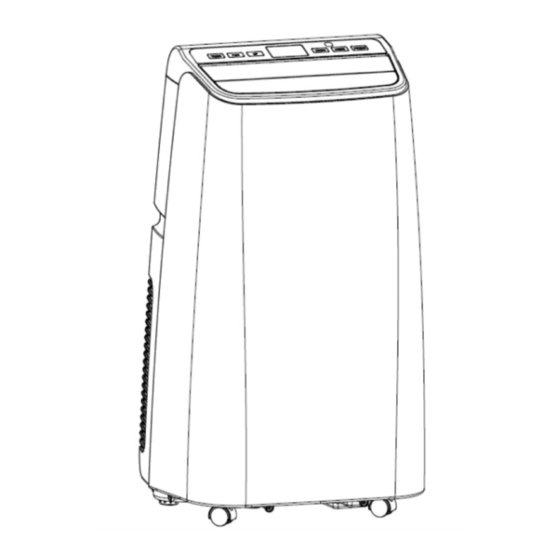
Advertisement
Quick Links
Advertisement

Summary of Contents for Shinco SPS-12C
- Page 1 Page: 1/21 SPS-12C 12000 BTU Portable A/C Instruction Manual...
-
Page 2: Table Of Contents
Page: 2/21 Content I. Notes ................3 II. Features and Components .............. 4 III . Installation and Ad j ustment............6 IV. Control Setting ................8 V. Dr amage Instructions ································································· 11 VI. Maintenance ............· 1 2 VII. Troubleshooting ................ 1 3 VIII. -
Page 3: Notes
Page: 3/21 Thank you for choosing this portable air conditioner.Please keep the manual for later review, and read the manual carefully before use. I. Notes Notes: The air conditioner is only suitable for indoor use, and is not suitable for other applications. * Insert the 3 pin plug into a properly grounded wall socket. -
Page 4: Features And Components
Page: 4/21 sical, sensor or mental capabilities if the have been iven supervision or instruction concernin use of the appliance in a safe wa and understand the hazards involved. Children shall not pla with the appliance. Cleanin shall not be done b children without supervision. - Page 5 Page: 5/21...
- Page 6 Page: 6/21 Slide...
- Page 7 Page: 7/21 Exhaust...
-
Page 8: Control Setting
Page: 8/21 IV. Control Setting Operating instructions: Operation interface is as follows: 女 卢 包 噶护 吩 � ,. 许 翱 凶 Timing ke Wind speed selection ke U p ke Displa window Down ke Mode selection ke Power key Remote control reception window when the machine is powered on for the first time, the control interface will beep, and then the machine will be into standb... - Page 9 Page: 9/21...
- Page 10 Page: 10/21 : press the key to switch between Celsius and Fahrenheit. III. A Variety of Protection Functions Frost Protection Function: In cooling, dehumidification or economic power saving mode, if the temperature of the exhaust pipe is too low, the machine will automatically enter protection status;...
-
Page 11: Dr Amage Instructions
Page: 11/21 V. Drainage Instructions 1. Manual draina 1) When the machine stops after the water is full, turn off the Machine's power and unplu the power plu Notes: Please move the machine carefull , so as not to spill the water in the water pan at the bottom of the bod 2)Place the water container below the side water outlet behind the bod 3)Unscrew the draina... - Page 12 Page: 12/21 conditioner...
-
Page 13: Troubleshooting
Page: 13/21 5: Cover the air conditioner with a plastic bag. Put the air conditioner in a dr place, keep it out of the reach of children, and take dust control measures. 6: Remove batteries of the remote control. Note: Store all the machines components, like hose, adaptor in a safe dry place. VII. -
Page 14: Appendix
Page: 14/21 VIII.Appendix Fuse Parameters Type: FSD or 50F Voltage: 250V Current: 3.15A Schematic Diagram Condenser Capillary Compressor Evaporator For model, technology and specific parameters please refer to product nameplate. Treatment: Don't put the abandoned machine with other unsorted waste together. Such waste shall be placed separately for other special use. - Page 15 Page: 15/21 BeforeInitiation To avoid damage, place the unit in an upright position for at least 24 hours before initiation. Make sure that the air outlet and air inlet are never blocked. Only operate the unit on a horizontal surface to ensure no water leaks out. Warnings Donot exceed impedance greeter than 0.236ohm in supply the appliance is connected to.
- Page 16 Page: 16/21 Additional warning for appliance with R290 refrigerant gas (refer to the rating plate for the type of refrigerant gas used) CAUTION ON FIRE READ THE MAUAL CAREFULLY BEFORE USING THE APPLIANCE R290 refrigerant gas complies with European environmental directives. This appliance contains approximately 235g of R290 refrigerant gas Appliance shall beinstalled, operated and stored in a room with a floor area larger than 12 m...
- Page 17 Page: 17/21 Instruction,RepairingAppliancesContainingR290 1. Checks to thearea Piror to beginning work on systems containing flammable refrigerants,safety checks are necessary to ensure that the risk of ignition is minimised. For repair to the refrigerants system, the following precaution shall be completed priort to conducting work on the system. 2.
- Page 18 Page: 18/21 marking to the equipment continues to be visible and legible. Markings and signs that are – illegible shall becorrected; refrigerating pipe or components are installed in a position where they are unlikely to be – exposed to any substance which may corrode refrigerant containing components, unless the components are constructed of materials which are inherently resistant to being corrodedoraresuitablyprotectedagainstbeingsocorroded.
- Page 19 Page: 19/21 12. Cabling Check that cabling will not be subject to wear, corrosion, excessive pressure, vibration, sharp edges or any other adverse environmental effects. The check shall also take into account the effects of aging or continual vibration from sources such as compressors or fans. 13.
- Page 20 Page: 20/21 16. Decommissioning Before carrying out this procedure, it is essential that the technician is completely familiar with the equipment and all its detail. It is recommended good practice that all refrigerants are recovered safely.Prior to the task being carried out, an oil and refrigerant sample shall be taken in case analysis is required prior to re-use of recovered refrigerant.
- Page 21 Page: 21/21 The recovered refrigerant shall be returned to the refrigerant supplier in the correct recovery cylinder, and the relevant waste transfer note arranged. Do not mix refrigerants in recovery units and especially not in cylinders. If compressors or compressor oils are to be removed, ensure that they have been evacuated to an acceptable level to make certain that flammable refrigerant does not remain within the lubricant.
















Need help?
Do you have a question about the SPS-12C and is the answer not in the manual?
Questions and answers